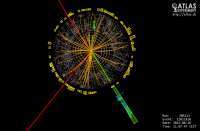Latest results indicate that new particle is a Higgs boson

Latest results from CERN further reinforce that the particle discovered last year is a Higgs boson.
Having analysed more data, the CMS and ATLAS experiments at the Large Hadron Collider (LHC) today presented their latest findings at the Moriond Conference in Italy. They find that the particle is looking more and more like a Higgs boson, the particle long-thought to give other particles mass.
"These latest findings reinforce what the ATLAS and CMS teams were reporting in 2012 with regard to the Higgs-like particle and show that we are closer than ever before to completing the Standard Model of particle physics." Dr Victoria Martin, University of Edinburgh ATLAS team.
UK particle physicist and ATLAS spokesperson Professor Dave Charlton from the University of Birmingham said: "The latest results mark a significant step in the measurements of the new boson, and use the full data sample collected so far by the LHC. It has been a great challenge for the experiments to produce such detailed analyses so quickly - it is a testament to the dedication of very many people that we could show them this week. With these results we see both that the decays, and the spin quantum number, of the new particle look like a Higgs boson."
ATLAS at Edinburgh
A team of 20 at the School of Physics & Astronomy is involved with the ATLAS project, and their work contributed to today's announcement. Among them are Chiara Debenedetti, a third-year PhD student in the Edinburgh Particle Physics Experiment group who is currently stationed at CERN for part of her PhD.
"The latest results are the outcome of hard and productive group work. These are amazing times to be a young experimental particle physicist, and I am very honoured to be one! We have the privilege of analysing data containing information that particle physicists have been seeking for a long time, and these data seem to confirm even more that we have seen the Higgs particle. A lot of measurements can be made now, to prove the nature of the particle we have found.
"The Edinburgh ATLAS group, which I am part of, is consistently participating in Higgs searches, and the excitement can be felt even more. Peter Higgs, Professor Emeritus at the University of Edinburgh, postulated his theory and the Edinburgh team is contributing towards proving it! It can be tiring sometimes to have tight deadlines and a lot of pressure, but the results ATLAS has been obtaining pay for all this hard work!" Chiara Debenedetti, third-year PhD student, Edinburgh Particle Physics Experiment group
Further questions raised
The key properties that allow us to say whether or not it is a Higgs particle are the strength with which it decays to other particles and its spin (intrinsic angular momentum) quantum number. Taken with the results on the decays of the particle, if it has spin-zero, as suggested in these latest results, then it is a Higgs particle.
Even then though, the work will be far from over. If the new particle is a Higgs, it could be the Higgs as predicted in the 1960s, which would complete the Standard Model of particle physics, or it could be a more exotic particle that would lead us beyond the Standard Model. The stakes are high. The Standard Model accounts for all the visible matter in the Universe, including the stuff that we are made of, but it does not account for the 96% of the Universe that is invisible to us - the dark universe. Finding out what kind of Higgs it is will rely on carefully measuring the particle's interactions with other particles, and that may take several years to resolve.
STFC pays the UK contribution to the CERN budget as well as supporting UK participation in the four LHC experimental detector projects, including the Higgs boson detectors ATLAS and CMS, and supports the University of Edinburgh Particle Physics Experiment group.

